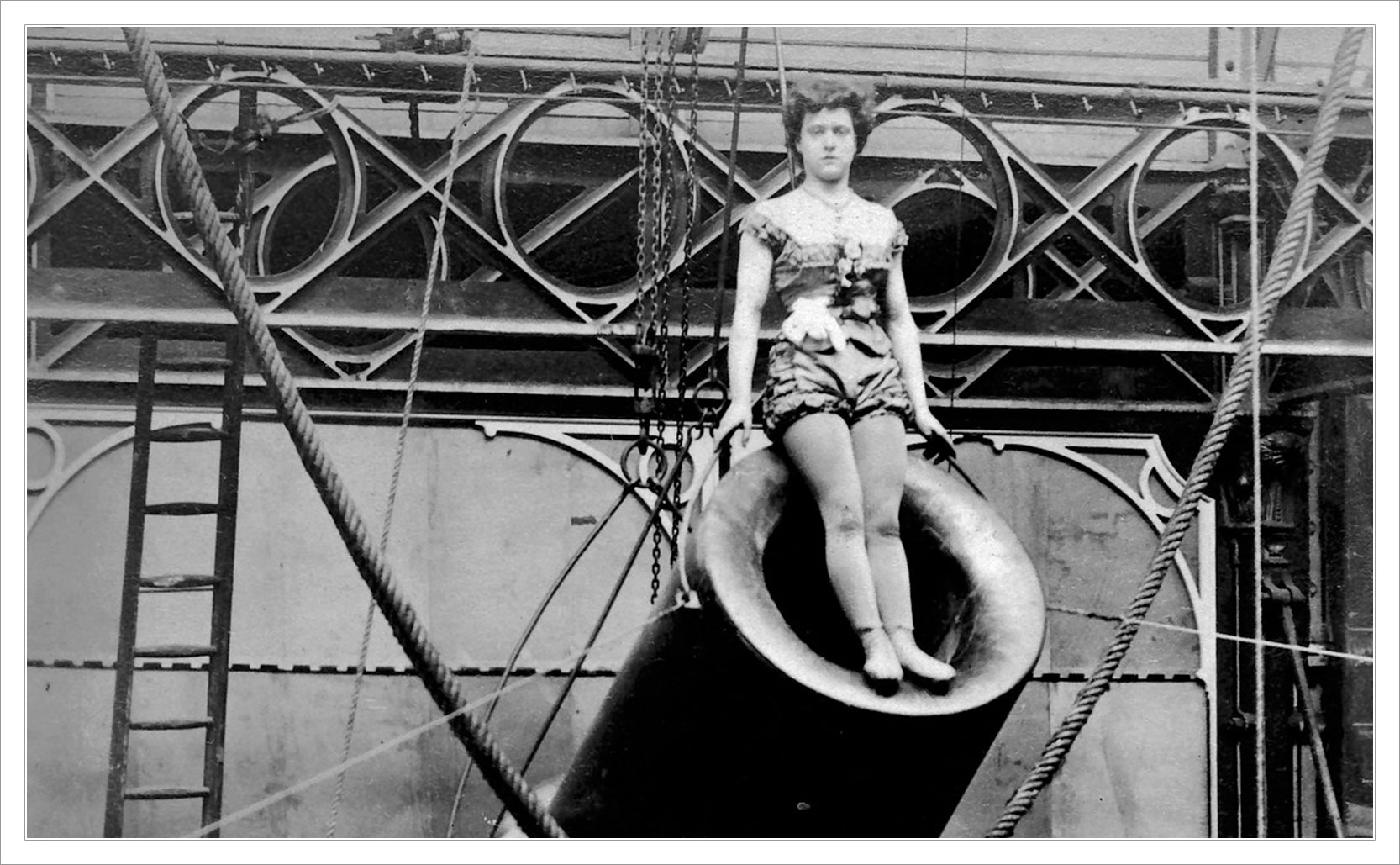The Human Cannonball
The most dangerous act in the circus.
William Hunt (aka “The Great Farini”) was a well known Canadian tightrope walker & daredevil. He crossed Niagara Falls on a tightrope multiple times performing different tricks. He eventually became an inventor & a (manipulative) talent manager as a safer way to make a living. In 1876 he invented a spring-loaded platform that could launch a person 30ft. He further developed this idea into the first human firing “cannon”.

The Cannon
The cannons used in the human cannonball act are not true cannons, there is no gunpowder used to propel the performer. Some are spring loaded but many use compressed air which pushes a small platform up the barrel firing the person out while the platform stays hidden inside. Sometimes a little explosion takes place outside the cannon to create smoke for dramatic effect, but there is no gunpowder used inside the cannon.
On April 10th, 1877 a 14-year-old Rossa Richter (aka. “Zazel”) became the first human cannonball with a performance at the Royal Aquarium in London, flying out of Hunt’s new cannon invention. She was chosen because of her size and her circus experience. The Royal Aquarium was chosen because its management was looking to increase their profits, and it worked. The human cannonball act soon became integral to circus performances as it could bring in thousands of paying spectators.

The Dangers of Being The Cannon Ball
The upsides of being a human cannonball are usually a fun stage name and that you only have to “work” for about 5 seconds a day. Unfortunately the dangers are obvious and quite real. Today’s cannons can apply 3,000 to 6,000 pounds of pressure on the performer as they accelerate from 0 to 70+ mph into the air. This can put enormous G-force pressure on a performer, sometimes up to 9 times normal gravity. All of this is damaging enough on the human body but the greatest danger is the landing. After reaching heights up to 75ft in the air and coming down sometimes 200ft away from where they started, human cannonballs have to land in the target area – there’s no other option. Some use nets, some use airbags, but to miss the target is as devastating as you might imagine.
Anton Barker (aka. “The Human Rocket” aka “Capt. George Wernesch”) incorporated a trick where he was inside a shell which he would break out of in mid-air. On March 29, 1937 he was set to travel 84 feet but only went 64, crashing into the ground injuring his spine. Mary Connors wanted to break a record by being shot from one side of the River Avon and land on the other. On August 24, 1974 she failed to make it to the other side and ended up in the river. To make matters worse the rescue boat then capsized so she and the rescue team had to be rescued.
On January 8, 1987 human cannonball Elvin Bale (aka. “the Human Space Shuttle”) knew something was wrong the instant he was in the air. He tried to adjust for it in mid-air but he overshot the airbag by a few feet, landing on the ground feet first. He broke his ankles, knees, and his back in two places.

The multi-generational Zacchini family produced numerous human cannonballs, performing for 70 years. Mario Zacchini ended his career as a human cannonball after he flew over a Ferris wheel at the 1939–40 World’s Fair in New York, but landed wrong breaking part of his spine, shoulder, and some ribs. On February 7, 1970 Emmanuel Zacchini and his wife Linda collided after being fired from a double-barreled human cannon. He fractured his spine while she broke her neck.
The Most Dangerous Act
Breaking bones is bad enough but fatalities are very common. One of the most cited human cannonball statistics comes from British historian A.H. Coxe. He estimates that of the 50+ people who have been human cannonballs, 30 have died while performing their act (almost all of which missed their landing). That’s a fatality rate of around 60%, making the human cannonball the most dangerous act in the circus.
Added info: Being a human cannonball is different than being a human catching a cannonball. Frank “Cannonball” Richards was a carnival performer famous in pop culture for taking a cannonball shot directly to the stomach.
Similar to the cannons used for human cannonballs, Frank Richards used a spring-loaded cannon instead of a real one fired by gunpowder. This slowed down the speed and force of the cannonball considerably … but he still took a 104lb cannonball to the stomach twice a day for years.


